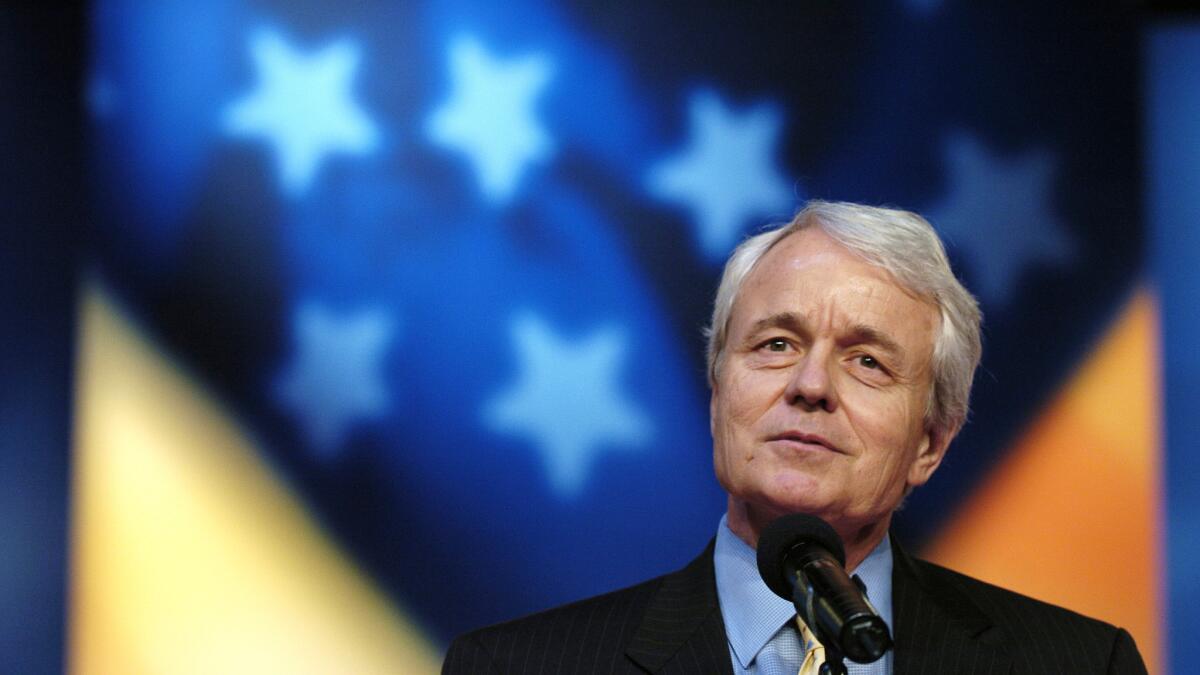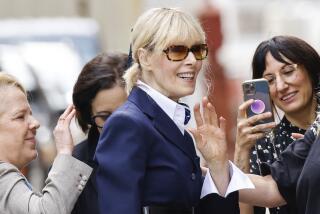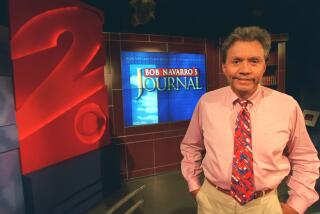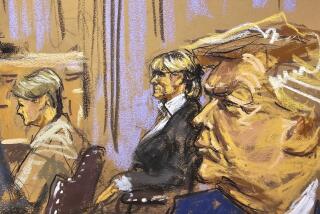John Carroll, editor who led L.A. Times to 13 Pulitzers, dies at 73

L.A. Times Editor John Carroll addresses the audience at the CNN/Los Angeles Times Democratic Presidential Primary Debate at USC in 2004.
Barely a week before the 2003 recall election that targeted California’s governor, a team of Los Angeles Times journalists led by Editor John S. Carroll put the finishing touches on a story that they knew could be a tinderbox.
They were right.
When the paper reported — five days before voters went to the polls — that actor-turned-GOP gubernatorial candidate Arnold Schwarzenegger had groped women, conservative commentators accused the paper of timing the story to help Democratic Gov. Gray Davis. Although Schwarzenegger won the election and admitted that he had “behaved badly” toward women, thousands of readers canceled their subscriptions.
Carroll met the criticism head-on.
“One of our goals is to do more investigative reporting,” he wrote in a commentary published after the election. “At the risk of offending still more readers, I’ll say that if you’re put off by investigative reporting, this probably won’t be the right newspaper for you in the years to come.”
Carroll, a courageous editor whose instinct for the big story and unrelenting focus on the craft of journalism guided the Los Angeles Times to new heights, including a record 13 Pulitzer Prizes in five years, died Sunday in Lexington, Ky., of Creutzfeldt-Jakob, a degenerative brain disease. He was 73.
His death was confirmed by his sister, Margaret Carroll.
Carroll joined The Times in 2000 after a distinguished career at the Philadelphia Inquirer, Kentucky’s Lexington Herald-Leader and the Baltimore Sun.
At The Times, he focused on investigative reporting and beat coverage, redesigned sections and changed the mix of columnists, including one who won a Pulitzer for criticism for writing about cars.
Of the 13 Pulitzers the paper won under Carroll, five were awarded in 2004. It was the largest number The Times ever won in a single year and the second-largest in the history of the prizes.
Times Editor Davan Maharaj said of Carroll: “Our continued success at the Los Angeles Times has been built on one key thing he preached: that producing great journalism was easier with teamwork, and would carry us further than whatever we would accomplish as individuals.”
“He was one of the most storied editors of his generation,” said New York Times Executive Editor Dean Baquet, who served as Carroll’s managing editor at the Los Angeles Times and later succeeded him as editor of the paper. “He knew how to deliver the big, big stories.”
Among them were examinations of patients’ deaths at Martin Luther King Jr./Drew Medical Center, which led to its closing. He also oversaw investigative series on fatal crashes involving the Harrier military airplane and the U.S. Food and Drug Administration’s approval of unsafe drugs.
The stories reflected his credo: “Write about life and death,” as he put it.
“Every place he went he gave people permission to have a bit of swagger, to believe in themselves,” said Norman Pearlstine, a close friend and chief content officer of Time Inc. “He just encouraged people to stretch, yet [he] would be that careful last reader whose notes on a story people treasured.”
Carroll took over The Times after a difficult period, when the paper was struggling to recover from a scandal involving a special edition of its Sunday magazine published under a profit-sharing agreement with Staples Center, the subject of the issue. The arrangement cast doubt on the paper’s independence.
With a genteel manner that belied his tenacity, Carroll moved quickly to restore the paper’s credibility and reputation, hiring top editors from other papers and pushing reporters to dig deep without worrying about who might be offended.
Carroll’s tenure coincided with growing financial distress for American newspapers and mounting demands to cut costs from Chicago-based Tribune Co., which had purchased The Times a month before his appointment. Adamant that “open-ended” cuts would damage the quality of the paper, Carroll resigned in 2005 after a little more than five years at the helm.
“John had great courage, quiet but consistent determination and a real understanding that a news organization is there to serve the public — let the chips fall where they may and never waver when it comes to telling the truth,” said Philadelphia Inquirer Editor William Marimow, who worked under Carroll at two papers.
His laser-like focus on the craft of journalism instilled devotion.
“John was the most charming, inspiring and exasperating editor I ever worked for,” said Julie Marquis, who edited the King/Drew series, which was honored with a Pulitzer for public service in 2005. “He’d put you through 30 drafts and then say in his gentlemanly, Southern way, ‘I think we’re making progress here.’ ... But you had to admit Draft 30 was a heck of a lot better than Draft 29, so you kept going, desperate to please him.
“Writers gave him every ounce of their talent, effort and respect,” she added.
John Sawyer Carroll was born in New York City on Jan. 23, 1942, and spent his early childhood in Winston-Salem, N.C. He was one of four children of Wallace Carroll, the editor and publisher of the Winston-Salem Journal and Sentinel, and the former Margaret Sawyer.
When Carroll was about 13, his father accepted a job in the New York Times bureau in Washington, D.C., and moved the family there. Richard Masland, who grew up with Carroll, described his friend as a mediocre student who enjoyed midnight raids on auto junkyards and other mischief.
But, Masland noted, he “was never the front man. He let other people actually do the raising of hell.” That trait was useful as an editor, when he guided reporters into controversial stories. “He had that charisma you have to have to get other people to do things,” Masland said.
At Haverford College in Pennsylvania, Carroll’s penchant for misbehavior got him tossed into jail with two buddies after a misguided effort to shake hands with baseball legend Willie Mays during a Phillies-Giants game.
The problem “was that Mays was standing in center field when John and his fellow inebriates decided to shake his hand,” said Pearlstine, a Haverford classmate.
After graduating in 1963 with a degree in English, Carroll was hired as a reporter at the Providence Journal in Rhode Island. He left in 1964 to join the Army, serving part of his time writing for a base newspaper in Alaska.
In 1966, after completing his military service, he joined the staff of the Baltimore Sun, which sent him to Vietnam to cover the war. He scooped fellow reporters with a story saying that the U.S. military was abandoning the Marine base at Khe Sanh, where it had fought one of the longest and bloodiest battles of the war.
The story nearly got him thrown out of the country.
Contending that Carroll had violated a news blackout on the evacuation of Khe Sanh, U.S. military officials threatened to yank his credentials. That provoked such an outcry in the press corps that “the military backed off and reduced John’s punishment to a one-month suspension,” recalled former New York Times Managing Editor Gene Roberts, who at the time was the paper’s Saigon bureau chief.
“John got a story out that badly needed to be told,” Roberts said “He comes over as sort of laid-back, gentlemanly in manner, all of which is true. But that conceals a determination to get the story — and get the story out.”
In 1972, after reporting stints for the Sun in the Middle East and Washington, D.C., Carroll was recruited to join the Philadelphia Inquirer by Roberts, who had become the paper’s editor.
Beginning as night city editor, he rose to metropolitan editor. He was deeply involved in shaping a series on brutality by Philadelphia police officers that won a Pulitzer for public service in 1978.
At the time, according to Roberts, investigative reporting was not a high priority at many papers. “It was on the back burner,” Roberts said. “John put it on the front burner.”
In 1979, Carroll left the Sun to become editor of the Lexington Herald-Leader. He led that paper to a Pulitzer in 1986 for a series exposing cash payments to University of Kentucky basketball players in violation of NCAA rules. The coverage resulted in advertising and circulation boycotts, protest rallies and a bomb threat but also brought changes in the university’s policies.
In 1991, after nearly a dozen years in Kentucky, Carroll returned to the Sun, this time as its top editor. He guided a Pulitzer-winning series on the deadly business of scrapping obsolete warships, called “shipbreaking.” He also oversaw a project that sent Sun reporters to southern Sudan to investigate the country’s slave trade.
At the Sun, Carroll had a prominent critic in David Simon, a crime reporter who later created the HBO series “The Wire.”
Simon took a buyout in 1995 when the staff was downsized in a cost-cutting move. Much of the last season of “The Wire,” in 2008, featured a character based on Carroll who had little regard for veteran Sun talent and a zeal for winning prizes that warped coverage of complex issues.
“Anyone who was there knows the truth,” said Marimow, who was the Sun’s managing editor under Carroll. “And I think the truth is that a newspaper that was somewhat inert in the late ‘80s and early ‘90s was resuscitated under the leadership of John Carroll.”
No one disputes that Carroll — who served on the Pulitzer board for nearly a decade and chaired it in 2002 — had his eyes on the awards at every paper he led. “His reputation was as a prize machine,” said Baquet, who didn’t know Carroll before he agreed to join him at the Los Angeles Times.
His focus on winning journalism’s top honor “was his way of raising the standards for reporting and writing all over the newsroom,” said Leo Wolinsky, a Times veteran who was deputy managing editor under Carroll. “And in my view, it was very effective in communicating his high expectations for everyone.”
Carroll was often described by associates as “old school,” which some saw as a weakness, particularly in regard to the digital news revolution.
Prior to his arrival, The Times had begun reshaping its newsroom to meet the challenges posed by the Internet. Like other editors of his generation, Carroll was perceived as slow to grasp the magnitude of the change required and disdainful of new media’s incursions on print’s turf. “Newspapers dig up the news. Others repackage it,” he told a gathering of newspaper editors in 2006 after leaving the paper.
At the same time, his focus on newspapers’ traditional mission — to be, in his words, “independent, principled, questioning, deep-digging” purveyors of news — was, to a large degree, just the medicine the paper needed in the spring of 2000.
When he arrived that April, he found a newsroom that was demoralized by the Staples controversy and wary of a future under Tribune, which had just paid $8.3 billion to purchase the Times Mirror Co. from its longtime owners, the Chandler family. (Times Mirror also owned the Sun and other papers.)
Before Carroll joined the paper, “we were at a collective nadir from a morale standpoint,” said David Willman, an investigative reporter in the Washington, D.C., bureau and Pulitzer winner. “John not only shored things up but took us to unprecedented heights. He steeled the operation with confidence.”
The new editor’s first major move — luring Baquet, one of the country’s highest-ranking African American editors, from the New York Times, where he was national editor — buoyed the staff and, with the support of Publisher John P. Puerner, he set in motion an overhaul. He not only replaced many of the top editors but shifted resources, largely dismantling the paper’s Orange County editorial staff and closing several weekly supplements while beefing up coverage in other areas, including investigative reporting, outdoor recreation and obituaries.
He was a hands-on editor who liked nothing better than to wield his pencil on a story. For the big stories, he pored over every word, sometimes re-crafting the first few paragraphs and writing captions and headlines. One of his best headlines, conceived in the spur of a moment, was for a story about the impact of a certain drug on the porn industry. He wrote: “Lights, Camera, Viagra!”
Displeased by language in a story about a Texas abortion bill, he wrote a memo cautioning section editors to avoid political bias, saying that he did not want The Times to push a “liberal agenda.” He also scolded the staff for using superlatives — writing that someone or something was “the best” or “the last” would bring a firm rebuke.
He was seen by some as being too aloof from the business side of the paper, but Puerner, who was publisher for most of Carroll’s tenure, said this was an unfair criticism.
“When we first met … he told me outright, ‘Sitting in business meetings is not my favorite. I’d rather be editing the newspaper.’ I accepted that,” Puerner said. “John couldn’t have been a better editor for the L.A. Times at that point in time.”
In the end, Tribune’s demands to cut expenditures drove Carroll away. A key moment came in the spring of 2004, after the paper had won five Pulitzers. As Times editors and honorees gathered in New York to collect the awards, Tribune brass ordered budget cuts.
Carroll resigned the following year.
“On the surface, it’s about cuts,” Carroll later told the New Yorker. “But it’s also about aspirations for the paper and for journalism itself.”
The Times was Carroll’s last newspaper. He went on to teach at Harvard University’s Shorenstein Center on the Media, Politics and Public Policy and chaired the board of the News Literacy Project, a national project teaching students how to be savvy consumers of information in the digital age.
When he became ill, he was at work on a book inspired by the Lexington Herald-Leader series about the University of Kentucky basketball payouts.
He is survived by his wife, Lee Carroll; daughters Maggie Vaughan and Katita Strathmann; stepchildren Huston Powell, Griggs Powell and Caroline Powell; sisters Margaret Carroll, Posie Carroll and Patricia Carroll; and nine grandchildren.
Twitter: @ewooLATimes
------------
FOR THE RECORD
John Carroll: In the June 15 Section A, the obituary of former Los Angeles Times Editor John Carroll said that he left the Baltimore Sun in 1979. He left the Sun in 1972. In 1979 he left the Philadelphia Inquirer to become editor of the Lexington Herald-Leader in Kentucky. In addition, an earlier online version said that Carroll was the second of three children of Wallace Carroll and the former Margarette Sawyer. He was one of four children.
------------
More to Read
Start your day right
Sign up for Essential California for the L.A. Times biggest news, features and recommendations in your inbox six days a week.
You may occasionally receive promotional content from the Los Angeles Times.







